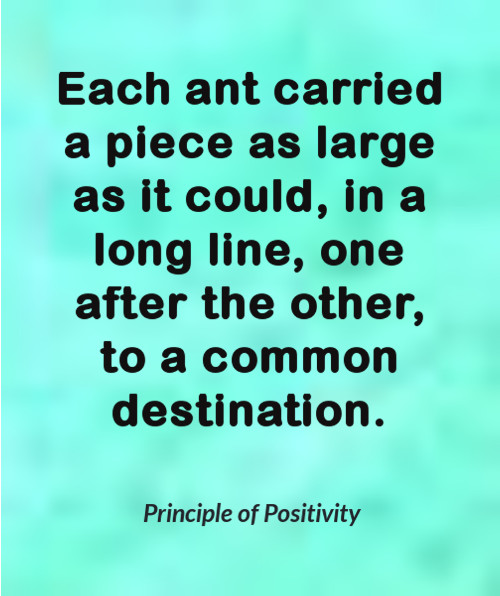The Principle of Positivity
It states that,
Helping others is helping yourself, the principle of positivity, has the potential to solve major real life problem, even at a global scale.

Help others is helping yourself, the principle of positivity, has the potential to solve major real life problem, even at a global scale.
This is a simple law that is violated in majority of situations rather than followed rigorously. The reasons this principle is inviolable are,
- We do not live alone - together we exist as a whole, nature included.
- Our well-being depends on the well-being of the environment in which we live. If the water in a pond gets polluted all the fishes suffer.
Conversely, if each of our actions creates overall positive effects, gradually it can turn a desert to a lush green valley.
Case example 1: Helping minds
In a class, during a problem based discourse, the teacher observed after a few sessions that each explained solution was not understood with equal clarity by all the students – that was usual but not ideally desirable. More importantly different students provided solutions on different occasions. “Why not push the students forward one step more”, the teacher thought.
He started a well-tested and highly effective learning process by inviting one of them to explain to the class the tricky solution of the problem being discussed. After initial hesitation, it was a good go. Then it was the turn of the next student-teacher and then the next.
This is a powerful way of learning, nothing new. It states,
To learn better, you teach what you have learned.
Gradually reluctance reduced and general level of understanding of the group increased.
One day after a fifteen minute tea break, when the students filed in the teacher remarked, “You took nearly 35 minutes.”
“Oh really!” one of them responded with a bit of surprise and explained, “The tea had to made fresh. That took time.” Another interjected, “And Sir, Raman explained to us the solution to the last problem you discussed."
“Any doubts now?” the teacher asked.
“No sir, it is absolutely clear now.”
That was voluntary peer level push, from the students themselves, not from the teacher.
“Now Raman clarified, next day Srija will”, the teacher told them.
In other words, generally,
If you help today, you will get help tomorrow.
Exactly that's what had happened two weeks later. No mystery there. It is natural. Isn't it?
Case example 2: Enabling your client
You were a Data Base Administrator working in a large bank who was your client. It was an important and difficult project for the consulting company who employed you and placed you in the Bank project.
This particular position was so tough that the last person holding it grew desperate, threw a few tantrums, somehow found you, and putting you on the hot seat fled. Now it was up to you to cope up with the daily pressure cooker situation.
You shared your worries with your wife. She asked, “But why did you take it?”
“I had no option.” You replied with quiet desperation.
You toiled on. Weeks passed. Months rolled on. After a year, you got an offer of a new project from your company. Your bank project was apparently closed. Your wife was surprised. She asked, “But it was a support job. How come it is finished?”
“I trained a capable person of the bank working with me. From now on the bank will look after this critical position independently.”
You smiled with the satisfaction of a job well done.
We don't classify helping others or creating overall positive results as purely philanthropic approach. To us, this approach is a practical and grounded means to achieve ultimate and sustainable good things for ourselves only. This principle of positivity to us is a foundational principle of problem solving.
